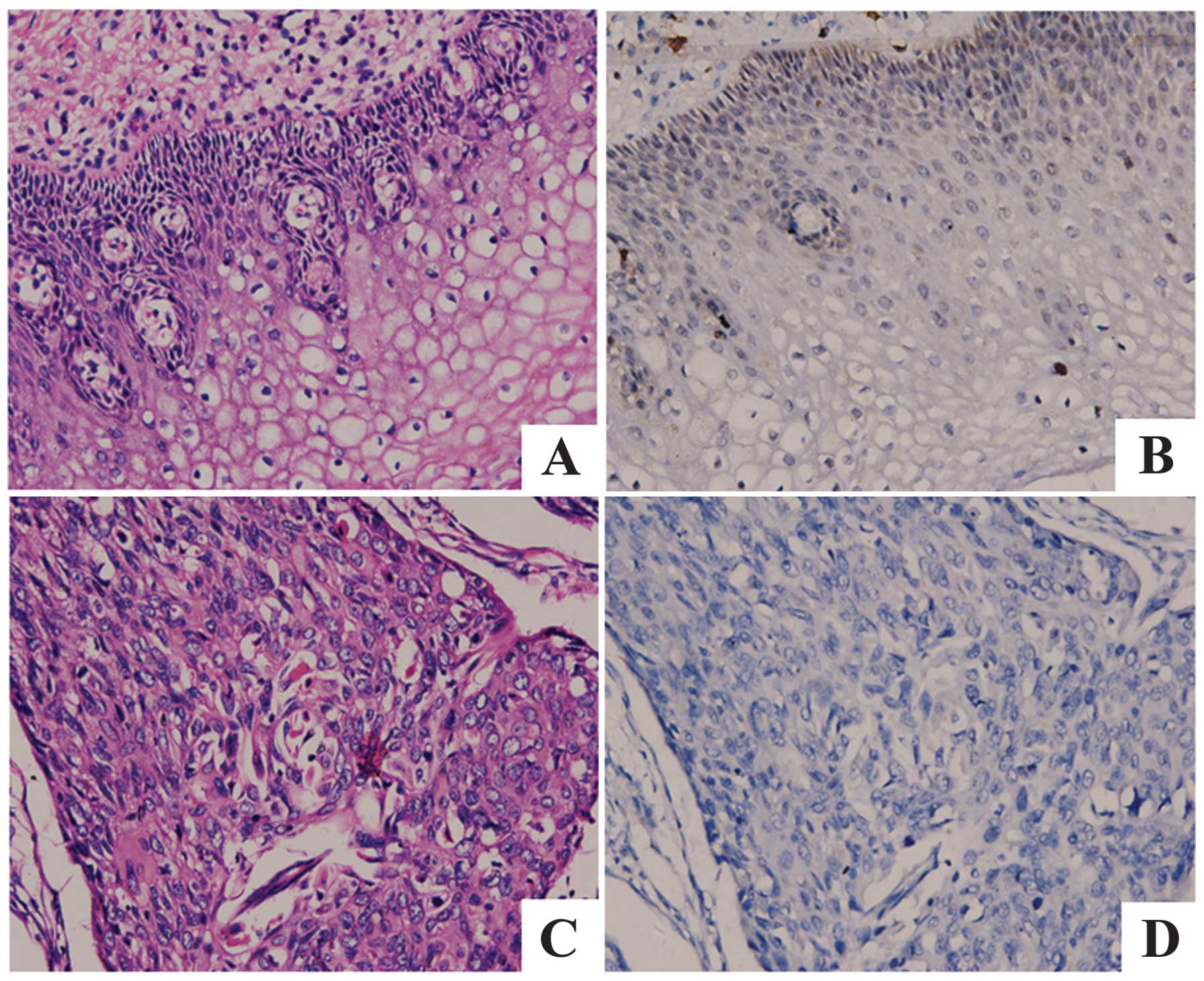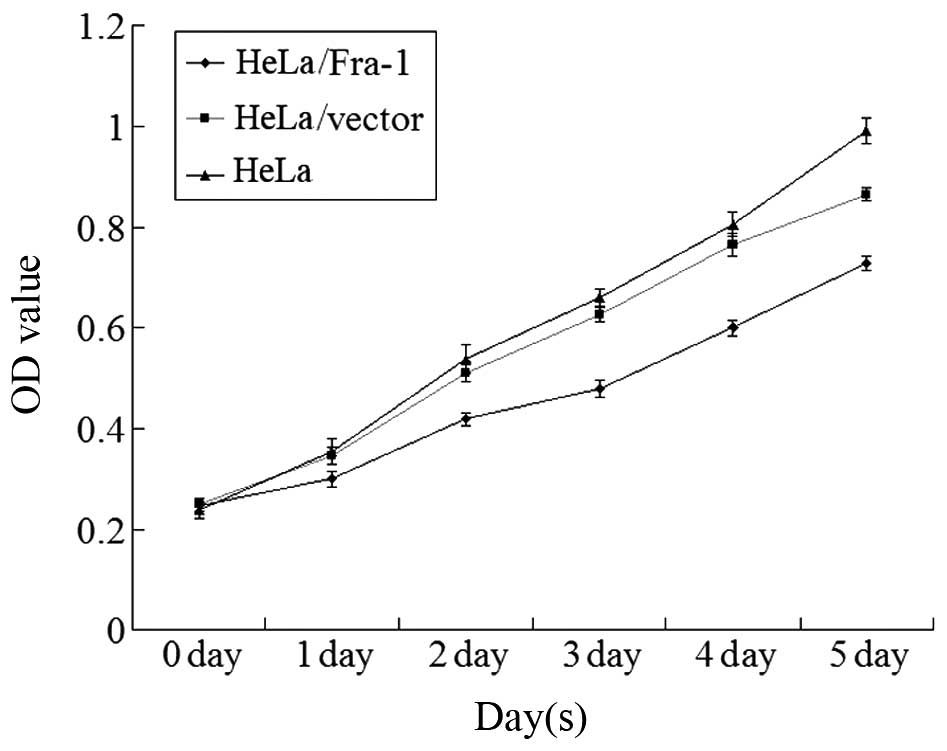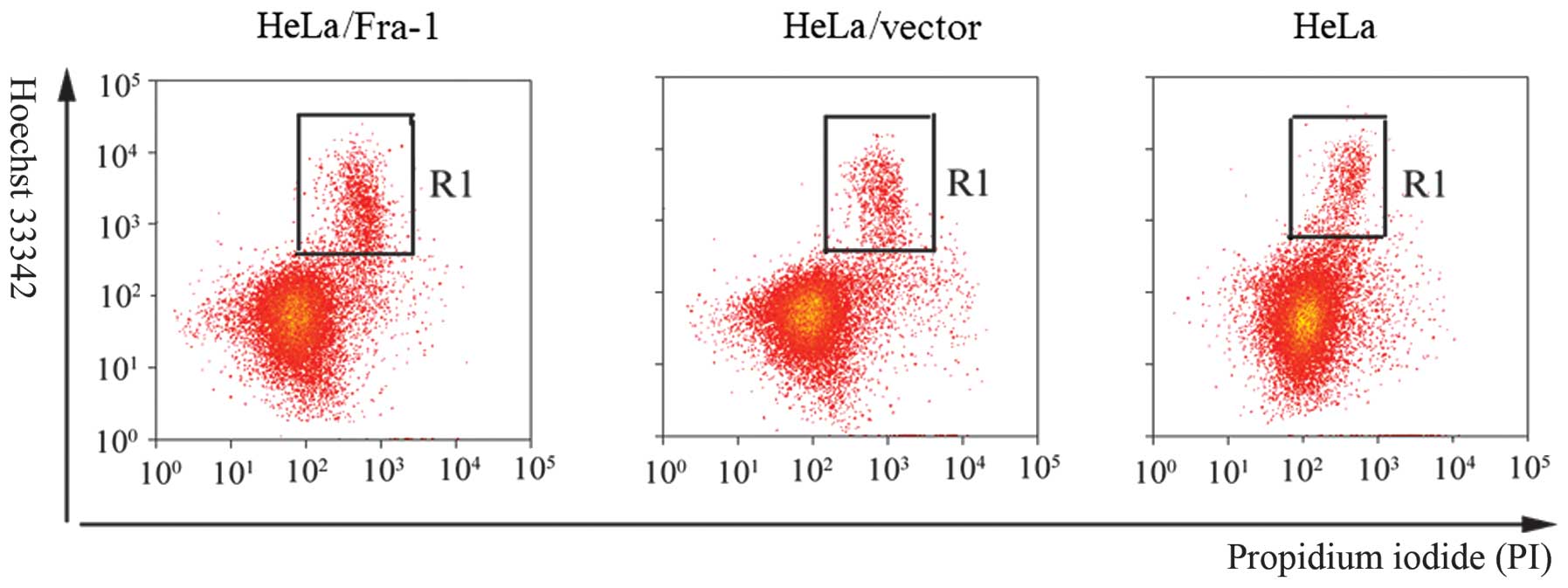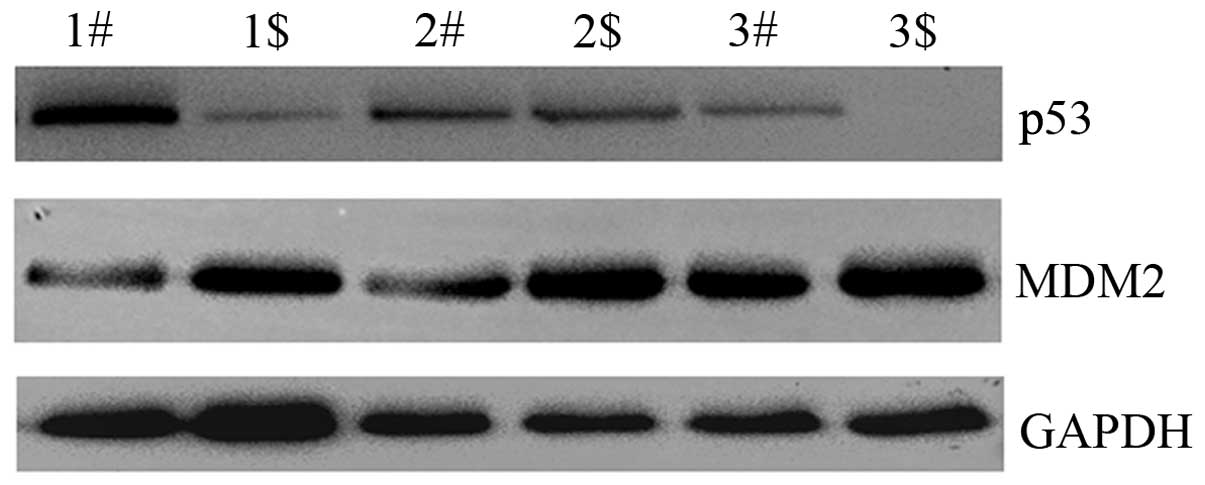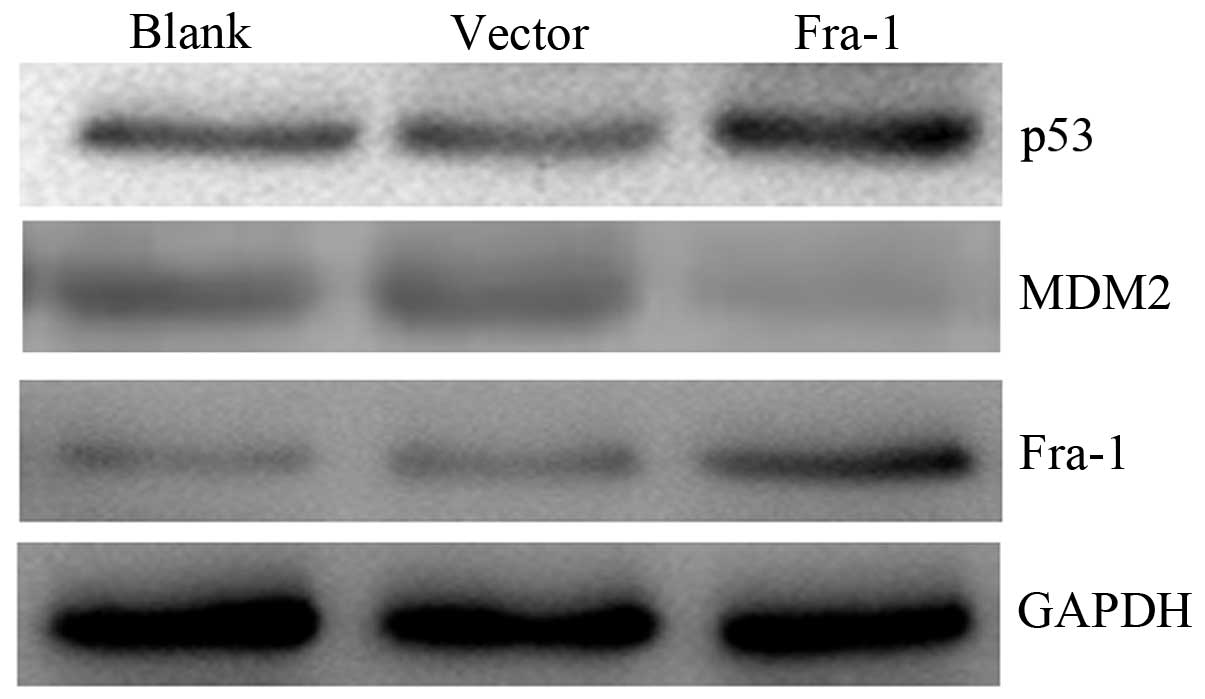|
1
|
Jemal A, Bray F, Center MM, Ferlay J, Ward
E and Forman D: Global cancer statistics. CA Cancer J Clin.
61:69–90. 2011. View Article : Google Scholar : PubMed/NCBI
|
|
2
|
Boutas I, Sofoudis C, Kalampokas E,
Anastasopoulos C, Kalampokas T and Salakos N: Fertility
preservation in women with early stage cervical cancer. Review of
the literature. Eur J Gynaecol Oncol. 35:373–377. 2014.PubMed/NCBI
|
|
3
|
He L, Wu L, Su G, Wei W, Liang L, Han L,
Kebria M, Liu P, Chen C, Yu Y, Zhong M and Wang W: The efficacy of
neoadjuvant chemotherapy in different histological types of
cervical cancer. Gynecol Oncol. 134:419–425. 2014. View Article : Google Scholar : PubMed/NCBI
|
|
4
|
Georgieva S, Iordanov V and Sergieva S:
Nature of cervical cancer and other HPV-associated cancers. J BUON.
14:391–398. 2009.PubMed/NCBI
|
|
5
|
Lazcano-Ponce E and Allen-Leigh B:
Innovation in cervical cancer prevention and control in Mexico.
Arch Med Res. 40:486–492. 2009. View Article : Google Scholar : PubMed/NCBI
|
|
6
|
Boshart M, Gissmann L, Ikenberg H,
Kleinheinz A, Scheurlen W and zur Hausen H: A new type of
papillomavirus DNA, its presence in genital cancer biopsies and in
cell lines derived from cervical cancer. EMBO J. 3:1151–1157.
1984.PubMed/NCBI
|
|
7
|
Dürst M, Gissmann L, Ikenberg H and zur
Hausen H: A papillomavirus DNA from a cervical carcinoma and its
prevalence in cancer biopsy samples from different geographic
regions. Proc Natl Acad Sci USA. 80:3812–3815. 1983. View Article : Google Scholar : PubMed/NCBI
|
|
8
|
Cheng JX, Yuan M, Li AL, Zhou P, Shen GQ
and Zhang Y: Quantitative analysis of P16 gene CpG methylation in
Uyghur patients with cervical squamous cell carcinoma and its
relationship with HPV16 infection. Genet Mol Res. 13:7428–7436.
2014. View Article : Google Scholar : PubMed/NCBI
|
|
9
|
Andersson S, Mints M, Gyllensten U,
Lindell M, Gustavsson I, Lambe M and Wilander E: Uneven
distribution of human papillomavirus 16 in cervical carcinoma in
situ and squamous cell carcinoma in older females: A retrospective
database study. Oncol Lett. 8:1528–1532. 2014.PubMed/NCBI
|
|
10
|
McLaughlin-Drubin ME and Munger K: Viruses
associated with human cancer. Biochim Biophys Acta. 1782:127–150.
2008. View Article : Google Scholar : PubMed/NCBI
|
|
11
|
Deivendran S, Marzook KH and Radhakrishna
Pillai M: The role of inflammation in cervical cancer. Adv Exp Med
Biol. 816:377–399. 2014. View Article : Google Scholar : PubMed/NCBI
|
|
12
|
Ramdass B, Chowdhari A and Koka P:
Cancer-initiating cells as target for prevention of recurring
disease etiology: role of these malignant putative progenitor cells
in relapse or metastasis of human cervical carcinoma. J Stem Cells.
8:233–251. 2013.
|
|
13
|
Luo Y, Zhou H, Mizutani M, Mizutani N,
Reisfeld RA and Xiang R: Transcription factor Fos-related antigen 1
is an effective target for a breast cancer vaccine. Proc Natl Acad
Sci USA. 100:8850–8855. 2003. View Article : Google Scholar : PubMed/NCBI
|
|
14
|
Luo Y, Zhou H, Mizutani M, Mizutani N, Liu
C, Xiang R and Reisfeld RA: A DNA vaccine targeting Fos-related
antigen 1 enhanced by IL-18 induces long-lived T-cell memory
against tumor recurrence. Cancer Res. 65:3419–3427. 2005.PubMed/NCBI
|
|
15
|
Cohen DR and Curran T: fra-1: a
serum-inducible, cellular immediate-early gene that encodes a
fos-related antigen. Mol Cell Biol. 8:2063–2069. 1988.PubMed/NCBI
|
|
16
|
Schreiber M, Poirier C, Franchi A,
Kurzbauer R, Guenet JL, Carle GF and Wagner EF: Structure and
chromosomal assignment of the mouse fra-1 gene, and its exclusion
as a candidate gene for oc (osteosclerosis). Oncogene.
15:1171–1178. 1997. View Article : Google Scholar : PubMed/NCBI
|
|
17
|
Desmet CJ, Gallenne T, Prieur A, Reyal F,
Visser NL, Wittner BS, Smit MA, Geiger TR, Laoukili J, Iskit S,
Rodenko B, Zwart W, Evers B, Horlings H, Ajouaou A, Zevenhoven J,
van Vliet M, Ramaswamy S, Wessels LF and Peeper DS: Identification
of a pharmacologically tractable Fra-1/ADORA2B axis promoting
breast cancer metastasis. Proc Natl Acad Sci USA. 110:5139–5144.
2013. View Article : Google Scholar : PubMed/NCBI
|
|
18
|
Lu D, Chen S, Tan X, Li N, Liu C, Li Z,
Liu Z, Stupack DG, Reisfeld RA and Xiang R: Fra-1 promotes breast
cancer chemo-sensitivity by driving cancer stem cells from
dormancy. Cancer Res. 72:3451–3456. 2012. View Article : Google Scholar : PubMed/NCBI
|
|
19
|
Casalino L, De Cesare D and Verde P:
Accumulation of Fra-1 in ras-transformed cells depends on both
transcriptional autoregulation and MEK-dependent posttranslational
stabilization. Mol Cell Biol. 23:4401–4415. 2003. View Article : Google Scholar : PubMed/NCBI
|
|
20
|
Zippo A, De Robertis A, Serafini R and
Oliviero S: PIM1-dependent phosphorylation of histone H3 at serine
10 is required for MYC-dependent transcriptional activation and
oncogenic transformation. Nat Cell Biol. 9:932–944. 2007.
View Article : Google Scholar : PubMed/NCBI
|
|
21
|
Casalino L, Bakiri L, Talotta F, Weitzman
JB, Fusco A, Yaniv M and Verde P: Fra-1 promotes growth and
survival in RAS-transformed thyroid cells by controlling cyclin A
transcription. EMBO J. 26:1878–1890. 2007. View Article : Google Scholar : PubMed/NCBI
|
|
22
|
Adiseshaiah P, Papaiahgari SR, Vuong H,
Kalvakolanu DV and Reddy SP: Multiple cis-elements mediate the
transcriptional activation of human fra-1 by
12-O-tetradecanoylphorbol-13-acetate in bronchial epithelial cells.
J Biol Chem. 278:47423–47433. 2003. View Article : Google Scholar : PubMed/NCBI
|
|
23
|
Adiseshaiah P, Peddakama S, Zhang Q,
Kalvakolanu DV and Reddy SP: Mitogen regulated induction of FRA-1
proto-oncogene is controlled by the transcription factors binding
to both serum and TPA response elements. Oncogene. 24:4193–4205.
2005. View Article : Google Scholar : PubMed/NCBI
|
|
24
|
Gruda MC, Kovary K, Metz R and Bravo R:
Regulation of Fra-1 and Fra-2 phosphorylation differs during the
cell cycle of fibroblasts and phosphorylation in vitro by MAP
kinase affects DNA binding activity. Oncogene. 9:2537–2547.
1994.PubMed/NCBI
|
|
25
|
Hurd TW, Culbert AA, Webster KJ and Tavaré
JM: Dual role for mitogen-activated protein kinase (Erk) in
insulin-dependent regulation of Fra-1 (fos-related antigen-1)
transcription and phosphorylation. Biochem J. 368:573–580. 2002.
View Article : Google Scholar : PubMed/NCBI
|
|
26
|
Milde-Langosch K: The Fos family of
transcription factors and their role in tumourigenesis. Eur J
Cancer. 41:2449–2461. 2005. View Article : Google Scholar : PubMed/NCBI
|
|
27
|
Belguise K, Milord S, Galtier F,
Moquet-Torcy G, Piechaczyk M and Chalbos D: The PKCθ pathway
participates in the aberrant accumulation of Fra-1 protein in
invasive ER-negative breast cancer cells. Oncogene. 31:4889–4897.
2012. View Article : Google Scholar : PubMed/NCBI
|
|
28
|
Kehrmann A, Truong H, Repenning A, Boger
R, Klein-Hitpass L, Pascheberg U, Beckmann A, Opalka B and
Kleine-Lowinski K: Complementation of non-tumorigenicity of
HPV18-positive cervical carcinoma cells involves differential mRNA
expression of cellular genes including potential tumor suppressor
genes on chromosome 11q13. Cancer Genet. 206:279–292. 2013.
View Article : Google Scholar : PubMed/NCBI
|
|
29
|
Soto U, Denk C, Finzer P, Hutter KJ, zur
Hausen H and Rösl F: Genetic complementation to non-tumorigenicity
in cervical-carcinoma cells correlates with alterations in AP-1
composition. Int J Cancer. 86:811–817. 2000. View Article : Google Scholar : PubMed/NCBI
|
|
30
|
Missero C and Antonini D: Crosstalk among
p53 family members in cutaneous carcinoma. Exp Dermatol.
23:143–146. 2014. View Article : Google Scholar : PubMed/NCBI
|
|
31
|
Bertheau P, Lehmann-Che J, Varna M, Dumay
A, Poirot B, Porcher R, Turpin E, Plassa LF, de Roquancourt A,
Bourstyn E, de Cremoux P, Janin A, Giacchetti S, Espié M and de Thé
H: p53 in breast cancer subtypes and new insights into response to
chemotherapy. Breast. 22(Suppl 2): S27–S29. 2013. View Article : Google Scholar : PubMed/NCBI
|
|
32
|
Tassone P, Old M, Teknos TN and Pan Q:
p53-based therapeutics for head and neck squamous cell carcinoma.
Oral Oncol. 49:733–737. 2013. View Article : Google Scholar : PubMed/NCBI
|
|
33
|
Ku JH, Byun SS, Jeong H, Kwak C, Kim HH
and Lee SE: The role of p53 on survival of upper urinary tract
urothelial carcinoma: a systematic review and meta-analysis. Clin
Genitourin Cancer. 11:221–228. 2013. View Article : Google Scholar : PubMed/NCBI
|
|
34
|
Tornesello ML, Buonaguro L and Buonaguro
FM: Mutations of the TP53 gene in adenocarcinoma and squamous cell
carcinoma of the cervix: a systematic review. Gynecol Oncol.
128:442–448. 2013. View Article : Google Scholar
|
|
35
|
Liu J, Ma Q, Zhang M, Wang X, Zhang D, Li
W, Wang F and Wu E: Alterations of TP53 are associated with a poor
outcome for patients with hepatocellular carcinoma: evidence from a
systematic review and meta-analysis. Eur J Cancer. 48:2328–2338.
2012. View Article : Google Scholar : PubMed/NCBI
|
|
36
|
Mitchell S, Mayer E and Patel A:
Expression of p53 in upper urinary tract urothelial carcinoma. Nat
Rev Urol. 8:516–522. 2011. View Article : Google Scholar : PubMed/NCBI
|
|
37
|
Nayak SK, Panesar PS and Kumar H:
Non-genotoxic p53-activators and their significance as antitumor
therapy of future. Curr Med Chem. 18:1038–1049. 2011. View Article : Google Scholar : PubMed/NCBI
|
|
38
|
Xiao S, Zhou Y, Jiang J, Yuan L and Xue M:
CD44 affects the expression level of FOS-like antigen 1 in cervical
cancer tissues. Mol Med Rep. 9:1667–1674. 2014.PubMed/NCBI
|
|
39
|
Liao S, Xiao S, Zhu G, Zheng D, He J, Pei
Z, Li G and Zhou Y: CD38 is highly expressed and affects the
PI3K/Akt signaling pathway in cervical cancer. Oncol Rep.
32:2703–2709. 2014.PubMed/NCBI
|
|
40
|
Zhu W, Li J, Su J, Li J, Li J, Deng B, Shi
Q, Zhou Y and Chen X: FOS-like antigen 1 is highly expressed in
human psoriasis tissues and promotes the growth of HaCaT cells in
vitro. Mol Med Rep. 10:2489–2494. 2014.PubMed/NCBI
|
|
41
|
Xiao S, Liao S, Zhou Y, Jiang B, Li Y and
Xue M: High expression of octamer transcription factor 1 in
cervical cancer. Oncol Lett. 7:1889–1894. 2014.PubMed/NCBI
|
|
42
|
Zhou Y, Wang W, Zheng D, Peng S, Xiong W,
Ma J, Zeng Z, Wu M, Zhou M, Xiang J, Xiang B, Li X, Li X and Li G:
Risk of nasopharyngeal carcinoma associated with polymorphic
lacto-transferrin haplotypes. Med Oncol. 29:1456–1462. 2012.
View Article : Google Scholar
|
|
43
|
Livak KJ and Schmittgen TD: Analysis of
relative gene expression data using real-time quantitative PCR and
the 2(−Delta Delta C(T)) method. Methods. 25:402–408. 2001.
View Article : Google Scholar
|
|
44
|
Hara A and Okayasu I: Cyclooxygenase-2 and
inducible nitric oxide synthase expression in human astrocytic
gliomas: correlation with angiogenesis and prognostic significance.
Acta Neuropathol. 108:43–48. 2004. View Article : Google Scholar : PubMed/NCBI
|
|
45
|
Salehi M, Taheri T, Mohit E, Zahedifard F,
Seyed N, Taslimi Y, Sattari M, Bolhassani A and Rafati S:
Recombinant Leishmania tarentolae encoding the HPV type 16 E7 gene
in tumor mice model. Immunotherapy. 4:1107–1120. 2012. View Article : Google Scholar : PubMed/NCBI
|
|
46
|
Sahiner F, Gümral R, Sener K, Yiğit N,
Dede M, Yapar M and Kubar A: Investigation of HPV-DNA in cervical
smear samples by two different methods: MY09/11 consensus PCR and
type-specific real-time PCR. Mikrobiyol Bul. 46:624–636. 2012.(In
Turkish). PubMed/NCBI
|
|
47
|
Song H, Wu F, Zhang Y, Zhang Y, Wang F,
Jiang M, Wang Z, Zhang M, Li S, Yang L, Wang XL, Cui T and Tang D:
Irisin promotes human umbilical vein endothelial cell proliferation
through the ERK signaling pathway and partly suppresses high
glucose-induced apoptosis. PLoS One. 9:e1102732014. View Article : Google Scholar : PubMed/NCBI
|
|
48
|
Yang M, Yang C and Pei Y: Effects of
downregulation of SIRT3 expression on proliferation and apoptosis
in esophageal squamous cell carcinoma EC9706 cells and its
molecular mechanisms. Biomed Mater Eng. 24:3883–3890.
2014.PubMed/NCBI
|
|
49
|
Chumakov PM: Function of the p53 gene:
choice between life and death. Biochemistry (Mosc). 65:28–40.
2000.
|
|
50
|
Harris SL and Levine AJ: The p53 pathway:
positive and negative feedback loops. Oncogene. 24:2899–2908. 2005.
View Article : Google Scholar : PubMed/NCBI
|
|
51
|
Chipuk JE and Green DR: Dissecting
p53-dependent apoptosis. Cell Death Differ. 13:994–1002. 2006.
View Article : Google Scholar : PubMed/NCBI
|



